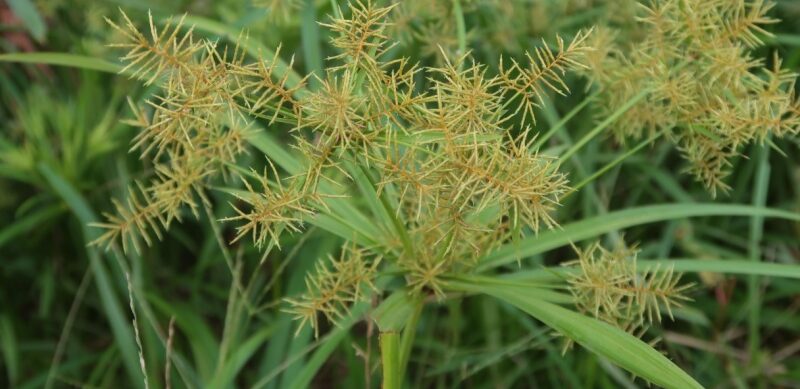Top 5 Summer Weeds in the Central Valley—And How to Eliminate Them

Summers in California’s Central Valley bring long, sun-soaked days, perfect for relaxing in your backyard. But with the rising heat comes an unwelcome invasion—summer weeds. These aggressive intruders thrive in dry conditions, stealing nutrients and water from your lawn and garden. Left unchecked, they can quickly take over, leaving you frustrated and battling an endless cycle of unwanted growth.
While some weeds may seem harmless at first, they compete fiercely for space, water, and nutrients, weakening grass, ornamental plants, and vegetable gardens. Spotting summer weeds early and using the right treatments can protect your lawn from an invasion. Identifying the most problematic offenders and applying the best strategies for elimination will ensure your yard remains weed-free all season long.
1. Crabgrass (Digitaria spp.) – The Opportunistic Invader
Crabgrass is one of the most frustrating summer weeds, sneaking into bare patches and quickly spreading across your lawn. Its ability to grow aggressively in heat makes it a top nuisance for homeowners. Once it takes hold, it can smother healthy turf, creating an uneven, unsightly lawn.
How to Stop It:
- Apply pre-emergent herbicides in early spring to prevent crabgrass seeds from germinating.
- Maintain a thick, well-fed lawn to naturally block crabgrass growth.
- Spot treat with post-emergent herbicides to eliminate crabgrass before it spreads.
- Mow at a higher height to shade the soil and prevent crabgrass seeds from sprouting.
- Water deeply but infrequently to support healthy grass while discouraging crabgrass takeover.
2. Nutsedge (Cyperus spp.) – The Persistent Survivor
Nutsedge, commonly called "nutgrass," is infamous for its ability to spread underground through hardy tubers. Its quick regrowth makes it one of the most challenging weeds to eradicate, often requiring specialized treatments beyond typical lawn care.
How to Stop It:
- Use herbicides specifically designed for nutsedge control to kill both surface plants and underground tubers.
- Avoid pulling it by hand, as broken tubers can produce multiple new plants.
- Improve lawn drainage to reduce the wet conditions nutsedge thrives in.
- Mow regularly to weaken nutsedge’s ability to spread and seed.
- Aerate compacted soil, making it less hospitable for nutsedge growth.
3. Spotted Spurge (Euphorbia maculata) – The Low-Growing Menace
Spotted spurge is a creeping weed that grows flat against the ground, invading lawns, sidewalks, and garden beds. It spreads quickly, producing thousands of seeds and making it a frustrating problem throughout the summer.
How to Stop It:
- Apply pre-emergent herbicides before peak summer temperatures to block new growth.
- Spot treat with broadleaf herbicides to kill existing spurge plants.
- Maintain proper lawn care—a thick, well-fed lawn naturally crowds out spurge.
- Pull young spurge plants before they mature to prevent seed production.
- Use mulch in garden beds to stop spurge from spreading in landscaped areas.
4. Bindweed (Convolvulus arvensis) – The Twisting Terror
A nightmare for homeowners, bindweed is a vine-like weed that wraps around plants, choking out flowers, vegetables, and small trees. Its deep root system makes it incredibly difficult to remove, often requiring multiple treatments.
How to Stop It:
- Use systemic herbicides that penetrate down to the roots.
- Prevent reseeding by cutting back bindweed before it flowers.
- Be patient—bindweed may take several treatments to fully eliminate.
- Install landscape fabric to block new bindweed growth in garden beds.
- Remove bindweed as soon as it appears, preventing it from establishing deep roots.
5. Foxtail (Setaria spp.) – The Sharp-Edged Intruder
Foxtail is more than just an unsightly weed—it poses serious risks to pets due to its sharp seed heads, which can lodge in fur, paws, and even throats. This fast-growing grass spreads aggressively in hot, dry conditions, making summer its peak growing season.
How to Stop It:
- Mow regularly to prevent seed heads from forming and spreading.
- Apply selective herbicides to kill foxtail without harming turfgrass.
- Overseed bare patches with desirable grass varieties to crowd out foxtail.
- Water properly to strengthen your lawn and prevent foxtail from taking over weak areas.
- Remove seed heads early to prevent future infestations.
- Use mulching techniques to block foxtail growth in garden beds.
Winning the Battle Against Summer Weeds
Controlling weeds isn’t just about eliminating them—it’s about keeping your lawn and landscape strong enough to resist them in the first place. Proper chemical treatments, combined with consistent lawn care, can dramatically reduce weed infestations and protect your turf from further invasions.
At The Experienced Gardener, we specialize in chemical lawn care solutions, pre-emergent treatments, and targeted weed control strategies to eliminate even the toughest summer weeds. Our expert techniques are tailored to Central Valley conditions, ensuring your lawn remains weed-free, healthy, and resilient all season long.
Don’t let summer weeds take over your yard! Contact The Experienced Gardener today to schedule a professional weed control treatment and enjoy a lush, hassle-free lawn all summer long. When it comes to stubborn weeds, expert care makes all the difference!


